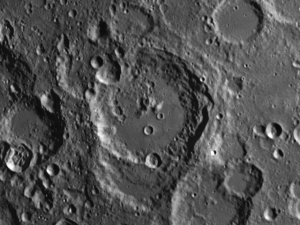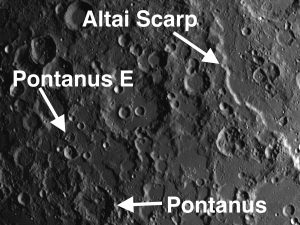The week of Dec. 5-11 takes us from Lunar Day 6 to Day 12, close to Full Moon. This week we will highlight the craters Eudoxus and Maurolycus, visible on Monday.
Eudoxus1: [NE/E11] Both Eudoxus and Aristoteles to its north are wonderfully complex craters with terraced walls. Look closely at the pair. It’s subtle, but can you see any features that would suggest which is older2? Just to the northeast of Eudoxus are three simple craters. Can you tell if their floors are bowl-shaped or flat?
 Maurolycus: [SE/P11] Let us venture briefly into a region where angels fear to tread, the lunar Highlands. Plunge in and look for the crater Maurolycus (at grid P11 on Sky & Tel’s Field Map of the Moon). Although the area looks confusing, Maurolycus will be the largest and most conspicuous crater in this sector. It is a breathtaking sight under an early morning Sun and should not be missed. Maurolycus displays a rich diversity of different types of features. How many can you see? The central mountain peaks are so tall that they are illuminated long before the Sun finds its way to the dark floor. Also notice how Maurolycus overlaps a smaller unnamed crater on its southern border. This flies in the face of the rule that says younger craters are smaller than their older brethren.
Maurolycus: [SE/P11] Let us venture briefly into a region where angels fear to tread, the lunar Highlands. Plunge in and look for the crater Maurolycus (at grid P11 on Sky & Tel’s Field Map of the Moon). Although the area looks confusing, Maurolycus will be the largest and most conspicuous crater in this sector. It is a breathtaking sight under an early morning Sun and should not be missed. Maurolycus displays a rich diversity of different types of features. How many can you see? The central mountain peaks are so tall that they are illuminated long before the Sun finds its way to the dark floor. Also notice how Maurolycus overlaps a smaller unnamed crater on its southern border. This flies in the face of the rule that says younger craters are smaller than their older brethren.
OF ADDITIONAL INTEREST ON THE MOON THE WEEK OF DECEMBER 5-11:
On Monday evening, in deep twilight, the Moon, Mars, and Venus will be in a more-or-less straight line just over the western horizon. Mars will have diminished to only 6.4 arc-seconds, so don’t expect to see any detail. Venus will be in a gibbous phase and 67% illuminated. Shortly after he acquired his first telescope, Galileo observed Venus going through all the phases of our Moon and realized this was proof positive that the Moon orbited the Sun and not the Earth. Observing Venus going through these phases allows you to recreate one of the greatest scientific discoveries ever made, as all of the academic institutions and the Church insisted that the Earth was the center of all movement.
 Also on Monday you might be able to make out Pontanus E [SE/M11], the only concentric crater on the Moon that isn’t on or near one of the “seas.” The placement of Pontanus E within the putative Werner-Airy basin lends credence to the suggestion that concentric crater inner rims are volcanic.
Also on Monday you might be able to make out Pontanus E [SE/M11], the only concentric crater on the Moon that isn’t on or near one of the “seas.” The placement of Pontanus E within the putative Werner-Airy basin lends credence to the suggestion that concentric crater inner rims are volcanic.
1Eudoxus: (c. 410-350 BCE) Greek astronomer and student of Plato who created a system of 27 spheres to account for the movement of the celestial bodies. This model of the solar system, in various forms and modifications (most famously by Ptolemy) persisted until Copernicus in the 1500s.
2The south wall of Aristoteles has been damaged and pushed in by debris that was ejected from the impact that created Eudoxus.
======================
It is highly recommended that you get a copy of Sky and Telescope’s Field Map of the Moon, the very finest Moon map available for use at the telescope. It is available for $10.95 at www.skyandtelescope.com and on Amazon. All features mentioned in this blog will be keyed to the grid on the Field Map and will look like this: Plato: [NW/D9]
Credits:
Courtesy of Gray Photography of Corpus Christi, Texas
Lunar photos: NASA / USGS / BMDO / LROC / ASU / DLR / LOLA / Moon Globe. Used by permission
- Rupes Cauchy: A Best Known Fault on the Moon - July 22, 2024
- Moon Crater Schickard – Crater Floor has Stripes - July 15, 2024
- Moon Craters Langrenus and Vandelinus - July 8, 2024

